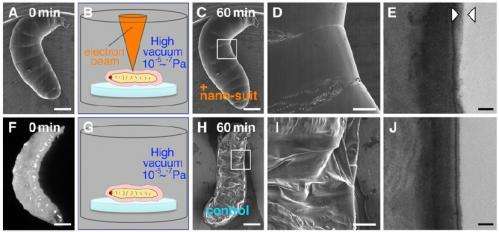(A–D) A living Drosophila larva was exposed to high vacuum with electron-beam irradiation for 60 min. (F and G) Before SEM observation, a different larva (light micrograph in F) was placed in the observation chamber without electron-beam irradiation for 60 min. (H and I) The specimen collapsed completely when subsequently observed by SEM. Each small white square in C and H is shown magnified in D and I, respectively. (E and J) TEM images are shown of vertical sections through the surface of each animal. The layer between the arrowheads in E indicates the limits of the newly formed outer membrane, not present in J. An outer layer covering the animal represents ECSs in B and G. Credit: (c) 2013 PNAS, doi: 10.1073/pnas.1221341110
(Phys.org) —Scientists use scanning electron microscopes (SEMs) to study tiny structures in small organisms. SEMs can only work in a high vacuum, and exposure to such a vacuum normally causes living things to die very quickly. Therefore, until now, scientists have been unable to study living specimens using SEMs. Takahiko Hariyama of the Hamamatsu University School of Medicine in Japan and his colleagues report that they were able to create "nanosuits" for small organisms by bombarding these organisms with electron beams or plasma radiation. In their paper, published in the Proceedings of the National Academy of Sciences, Hariyama's team reports that these nanosuits provide protection against a high vacuum, allowing the organisms to stay alive in SEMs while scientists analyze them.
Exposure to a high vacuum causes living things to become dehydrated, collapse and die. This poses a problem for scientists who want to study fine structures on small organisms, because they must use SEMs to view these structures. They can only observe dead creatures, so do not get a true picture of how these structures appear on living ones.
Hariyama and his team tested how long different kinds of organisms would live in an SEM. As expected, almost all of the living things they studied died quickly. However, to their surprise, fruit fly larvae moved around for a full hour while in the SEM.
When the researchers placed fruit fly larvae in a high vacuum SEM observation chamber, but waited an hour before exposing the larvae to electron beams, the larvae all died, indicating that electrons somehow aided the other group's survival.
The researchers found that treatment with electron radiation causes a gooey extracellular substance (ECS), which normally covers fruit fly larvae, to polymerize, forming a 50-100 nanometer thick surface layer. They called this layer, between 1,000 and 2,000 times thinner than a human hair, a "nanosuit." This nanosuit, while flexible enough to allow the larvae to move, acts as a protective barrier against the vacuum, preventing severe dehydration and enabling the larvae to survive.
Hariyama and his team found that they could cause nanosuits to form on fruit fly larvae, as well as on other insects with ECS coatings, by exposing them to ionized plasma particles as well as electrons.
They were able to create protective nanosuits for mosquitoes, which do not have natural coatings, by immersing them in Tween 20, a non-toxic chemical found in detergents, and then exposing them to plasma radiation.
The researchers point out that plasma and energetic electrons, which exist throughout the universe, could help coated organisms form their own protective nanosuits and survive the vacuum of space.
More information: A thin polymer membrane, nano-suit, enhancing survival across the continuum between air and high vacuum, PNAS, Published online before print April 15, 2013. doi: 10.1073/pnas.1221341110
Abstract
Most multicellular organisms can only survive under atmospheric pressure. The reduced pressure of a high vacuum usually leads to rapid dehydration and death. Here we show that a simple surface modification can render multicellular organisms strongly tolerant to high vacuum. Animals that collapsed under high vacuum continued to move following exposure of their natural extracellular surface layer (or that of an artificial coat-like polysorbitan monolaurate) to an electron beam or plasma ionization (i.e., conditions known to enhance polymer formation). Transmission electron microscopic observations revealed the existence of a thin polymerized extra layer on the surface of the animal. The layer acts as a flexible "nano-suit" barrier to the passage of gases and liquids and thus protects the organism. Furthermore, the biocompatible molecule, the component of the nano-suit, was fabricated into a "biomimetic" free-standing membrane. This concept will allow biology-related fields especially to use these membranes for several applications.
Journal information: Proceedings of the National Academy of Sciences
© 2013 Phys.org























